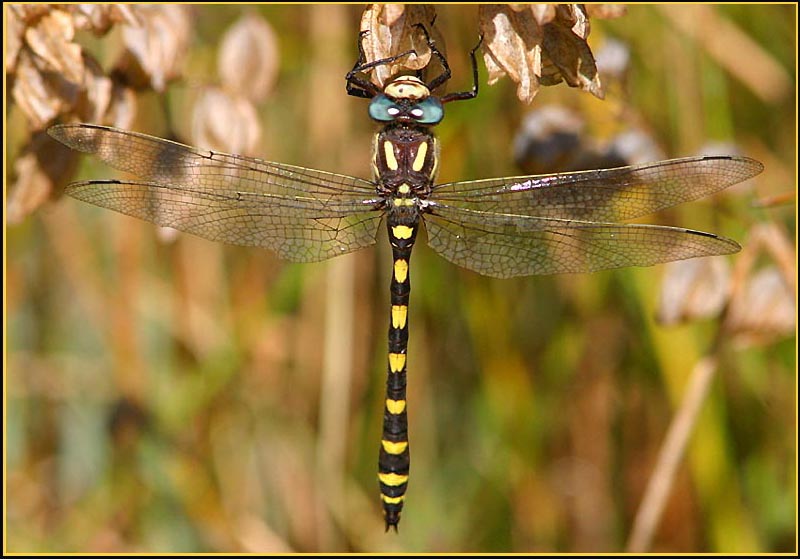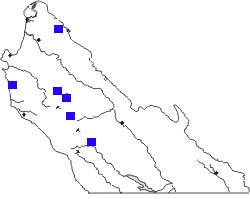| |
|
|
PACIFIC SPIKETAIL
Cordulegaster dorsalis
|

|
|
Pacific Spiketail is a huge, striking,
fearless dragonfly. It is
an agile predator of flying insects, including other dragonflies, and
has
a fearsome face close up (above). But when perched it is a gorgeous
jewel
(below). The black-and-yellow dragon is so impressive that it has been
known by various evocative colloquial names, including "biddy" and
"flying
adder." In England, members of this family are called "goldenrings."
Pacific
Spiketail is the only member of this family (Cordulegastridae) in
California.

photo (uppermost
head detail) 28 Sep 2006
Mud Creek
photo (above, full body; male) 9 Sep
2006 Wagon Caves,
The Indians
photo (below; female) 3 Sep 2006
Soberanes Creek, Garrapata
SP
|

Both sexes are similar in size (3+ inches long) and color pattern but
females (right) can be recognized by their impressive ovipositor at the
tip of the abdomen. It looks like a spike, but is actually an enlarged
vulvar lamina from the bottom side of the 8th abdominal segment.
Females
rarely visit water except to breed and oviposit. The ovipositor is used
to deposit her eggs. This is "accomplished alone by hovering vertically
over shallow water and repeatedly plunging the ovipositor into the
muddy
or sandy substrate;" (Manolis 2003). This is an exceptional sight to
see.
Manolis (2003) says that Pacific Spiketails are
"nearly always seen
in flight." This has certainly been my experience — they are constantly
on the move, and thus quite difficult to watch. You know something
impressive
just went by... but it happened so fast! The photos of individuals on
this
page were lucky, serendipitous events. The story of a couple of these
interactions,
along Soberanes
Creek and at Wagon
Caves, are told elsewhere on this web site.
|
|
Males patrol long stretches along streams, or
even along back roads,
looking for females. Although they attract aggressively toward other
males,
they are not thought to delimit or defend specific territories (Vick
2001).
The male below was patrolling a dirt road in northeastern Monterey
County;
however, in MTY, most are found along shaded streams. Even then, they
"are
not commonly seen except at just the right time and place;" Dunkle
(2000).
photo (above;
male) 28 Sep 2006 along upper
Old Stage Road
photo (below; male) 9 Sep 2006 Wagon
Caves, The Indians
|
On the rare occasions when a Pacific Spiketail is
perched, it can still
be difficult to spot because in hangs low from multicolored leaves,
weeds,
or bushes, and its colorful pattern blends remarkably well. When it is
spotted, it might look like a displaced child's toy to the non-odonite
eye (below).

|
In European species, individual spiketails
(goldenrings) may live 3-5
years. Of course much of this is in a nymph stage underwater, but this
is still much longer than most other odes. Presumably the adults may be
active for several months.
 This
map (right) shows the approximate locations of MTY records to date.
Some
11 of these records are specimens from Hastings NHR and vicinity in
upper
Carmel Valley, and another is a specimen of a larvae collected 29 Mar
1988
in Piney Creek, 14 miles west of Greenfield (#UC Sacramento). The other
currently 'known' locations are Soberanes Creek in Garrapata State
Park;
tributaries of the north fork of the San Antonio River; and adjacent to
Mud Creek, along Old Stage Road, east of Salinas. This
map (right) shows the approximate locations of MTY records to date.
Some
11 of these records are specimens from Hastings NHR and vicinity in
upper
Carmel Valley, and another is a specimen of a larvae collected 29 Mar
1988
in Piney Creek, 14 miles west of Greenfield (#UC Sacramento). The other
currently 'known' locations are Soberanes Creek in Garrapata State
Park;
tributaries of the north fork of the San Antonio River; and adjacent to
Mud Creek, along Old Stage Road, east of Salinas.
Records of flying spiketails range between 3
June-28 Sep. Elsewhere
in California flight dates are mid-May to early October (Manolis 2003).
In MTY it is mostly seen between July and September.
|
|
|
Literature cited:
- Dunkle, S.W. 2000. Dragonflies through Binoculars: a
Field Guide to the
Dragonflies of North America. Oxford Univ. Press, New York.
- Manolis, T. 2003. Dragonflies and Damselflies of
California. Univ. of Calif.
Press, Berkeley.
- Vick, G.S. 2001. Family Cordulegastridae
(Goldenrings) in Dragonflies
of the World (J. Silsby, ed.). Smithsonian, Washington, D.C.
Web resources:
Major identification web sites with much information on California
odes include:
For sites with excellent photos to compare for identification or to
simply
enjoy, see:
Many of these sites have links to other useful pages. Kathy Biggs's
site
is particularly useful in her selection of links. |
|
All photos © Don Roberson 2007
TOP
|
|
|
Page created 15-18 Feb 2007
|
|
|
|
|
